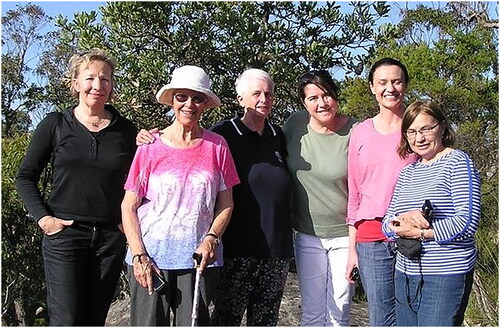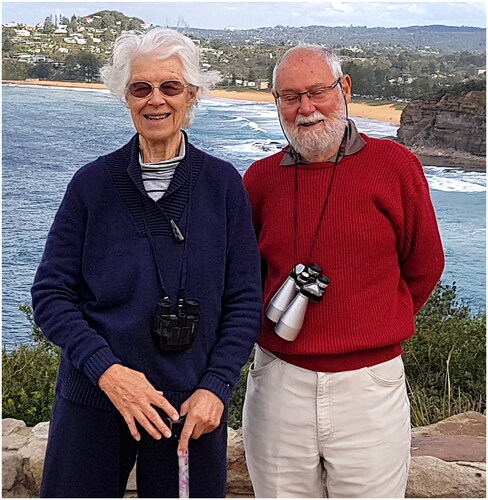When notice of Tessa’s death was posted on the Ozarch list, various responses pointed to the calibre of an esteemed researcher, colleague and friend (AACAI Citation2024; Smith Citation2024; Vines Citation2024; Wright Citation2024). Tessa () touched many people with her wit, candour and integrity. She had a way of asking, in an innocent tone but a direct manner, thorny questions that had complex answers. Readers who wish to gain a sense of her personality (and perhaps to recall their own memories) may like to read Tessa’s ‘Breccia’ column in the AACAI Newsletter (see access details below in the reference list).
Tessa was born in Ealing, England, in 1935. Her family moved to Australia in 1950. She did well at Meriden School in Strathfield and was offered a scholarship to university, but her parents were against her going. So soon after leaving school, Tessa travelled to Europe with her friend Judith, with an adventurous spirit and enquiring mind. Tessa married and moved to Hong Kong in c.1958. In the ‘colonial’ society of the time, wives of expats were not permitted to work, so Tessa sought voluntary work. She joined the Marco Polo Club where she met Dr Solomon (‘Solly’) Bard and started her involvement with archaeology, taking part in digs around Hong Kong in the early 1970s.
The Corkill family moved from Hong Kong to Sydney in 1975. Solly Bard had spent 1967 at the Australian Museum with David Moore, the Museum’s curator of Anthropology at the time. Through these connections Solly introduced Tessa to David Moore and she became a volunteer at the Museum. This included taking part in the second of David’s excavations in the Hunter Valley in 1976–1977 and working with him on the subsequent artefact analysis. Tessa also joined the (now defunct) Anthropological Society of NSW, where she met Val Attenbrow who was also a member.
Tessa and Val became friends, and Tessa remained a devoted collaborator with Val. This included voluntary work for the Upper Mangrove Creek project and analysis of stone types in several artefact assemblages for Val’s Port Jackson project (e.g. Corkill Citation1995, Citation2000). Tessa’s professional thoroughness, attention to detail and commitment to task, were the perfect recipe for a successful working relationship with Val. Tessa remained associated with the Museum for the rest of her life as a volunteer, temporary staff member (1978–1980, 1986–1990) and research associate.
The next challenge for Tessa was an undergraduate degree in the Department of Anthropology at the University of Sydney, a goal which had been denied to her as a younger woman. She completed her Honours thesis in 1986, exploring a geoarchaeological approach to the Holocene Shoalhaven River embayment (Corkill Citation1986). Of concern was how geomorphological changes to a coastal landscape may have influenced the cultural landscape, and whether available archaeological data were sufficient to test various models relevant to that topic. While her thesis emphasised environmental factors, Tessa acknowledged the ‘… actors in the landscape … (as) … they always remain the central reason for our interest in patterns of the past’ (Corkill Citation1986:113).
The importance of life’s actors was highlighted for Tessa when she met John Edgar during her undergraduate studies. Tessa’s partnership with John continued for 40 years (), and she affectionately and often referred to him in her ‘Breccia’ column in the AACAI Newsletter. In 1988 Tessa and John moved to a bushland setting in Glenorie, north-west Sydney. This location was ideal for Tessa and John to learn about nature—its flora, fauna and geology, and its expression as a cultural landscape. Tessa developed a strong interest in the local Maroota Sand, contributing to an understanding of its formation and age (Graham et al. Citation2010).
Tessa continued her interests in geoarchaeology, completing a Master’s Thesis at the University of Sydney (Attenbrow et al. Citation2008; Corkill Citation1997, Citation1999, Citation2005). The research focused on identifying potential sources of artefact stone, especially silcrete which was the primary rock type used for the production of stone artefacts on the Cumberland Plain of western Sydney. This is a sound body of research, including an understanding of previously published geological literature, ground-truthing of potential sources of artefact stone, and use of thin sections and PIXE-PIGME analysis (Proton Induced X-ray Emission and Induced Gamma-ray Emission). She concluded that silcrete occurred naturally as boulders and cobbles in an ancient fluvial deposit, which outcropped in several locations across the northern Cumberland Plain, and it was not possible to distinguish between silcretes from different outcrops of this deposit.
Tessa’s home in Glenorie became an important (secondary) source of silcrete material for experimental research, reference collections and various knapping related activities. Silcrete from Tessa’s shed is found widely across the Sydney region—in reference and private collections, cached for future knapping and in a garden or two. Silcrete has travelled, via Tessa’s academic exchange network, to at least one interstate university campus, as a resource for teaching.
During her time at the Australian Museum, Tessa used her extensive knowledge of the geology of the Sydney Basin to identify potential sources for more than 300 ground-edged implements (hatchets) and other artefacts that had been found throughout the Sydney region and held at the Museum (Corkill Citation2005). Aspects of this work were later incorporated into an ARC Discovery Grant (titled ‘Axes, exchange, social change’) led by Val Attenbrow and Peter Grave. Analysis techniques used in this project included non-destructive provenancing techniques (pXRF) to better understand the role of ground-edged implements in trade and exchange systems in past Aboriginal societies. The areas of investigation extended from the Sydney region and included the Central Coast, Hunter Valley, Illawarra and Blue Mountains.
Tessa was a valuable member of the pXRF team () and helped identify and collect specimens from potential geological sources within the Sydney Basin. This involved numerous field trips with the team and resulted in a comprehensive geological reference collection for volcanic and metamorphic rocks. Several ground-edged implements including hatchets, wedges and Bulga knives were subsequently matched to sources which identified extensive local and long-distance trading patterns. This project is ongoing, but has already led to numerous publications to which Tessa contributed (Attenbrow et al. Citation2012, Citation2017, Citation2019), as well as conference presentations at the Australian Museum (2013), Department of Archaeology at the University of Sydney, Australian Archaeological Association Annual Conferences in 2012, 2013 and 2014, World Archaeological Congress WAC-7 at The Dead Sea in Jordan (2013), and the Indo-Pacific Prehistory Association Conference at Seam Reap in Cambodia (2014).
Figure 2. Tessa with some members of the ARC Discovery Grant pXRF team during a trip to Kulnura in 2015. Left to right Angela Rosenstein, Tessa Corkill, Val Attenbrow, Rebecca Bryant, Karen Stokes and Nina Kononenko (Photograph Hugh Watt, who was also a member of the team).

Tessa’s achievements were not limited to research, as she was also active in consulting archaeology, with about 70 reports written between 1989 and 1999, listed in the Aboriginal Heritage Information Management System (AHIMS) in NSW. Tessa’s enquiring mind did not always stop with the completion of a consultancy, but she sought answers to bigger questions, such as the nature of rock shelter taphonomy (Corkill Citation1993, Citation2001). Tessa was also active in the Australian Association of Consulting Archaeologists Inc (AACAI), volunteering as Membership Secretary from 1994 to 1997, and Vice President in 1999.
Tessa was a remarkable person, with an astute and enquiring mind. She sought to learn but was also keen to give. She touched many people’s lives—family, friends and colleagues. She is sadly missed, but we raise a glass to her, applaud her achievements and thank her for letting us know her ().
Disclosure statement
No potential conflict of interest was reported by the author(s).
References
- AACAI 2024 Recent Passing of Tessa Corkill Message posted to AACAI members 6 February 2024, retrieved 22 April 2024 from Recent Passing of Tessa Corkill (aacai.com.au).
- AACAI Newsletters No. 40 March 1989 to No. 81 December 1999. Retrieved 22 April 2024 from https://www.aacai.com.au/2019/10/10/newsletters-archive/.
- Attenbrow, V., T. Doelman and T. Corkill 2008 Organizing the manufacture of Bondi points at Balmoral Beach, Middle Harbour, Sydney, NSW, Australia. Archaeology in Oceania 43 (3):104–119.
- Attenbrow, V., I. Graham, N. Kononenko, T. Corkill … P. Grave 2012 Crossing the great divide: A ground-edged hatchet-head from Vaucluse, Sydney. Archaeology in Oceania 47 (1):47–52.
- Attenbrow, V., T. Corkill, R. Pogson, L. Sutherland and P. Grave 2017 Non-destructive provenancing of ground-edged mafic artifacts: A Holocene case study from the Sydney Basin, Australia. Journal of Field Archaeology 42 (3):173–186.
- Attenbrow, V., R. Bryant, T. Corkill, R. Pogson and P. Grave 2019 Geological sources and chronological change in ground-edged artefacts of the Hawkesbury Region, the Sydney Basin: A Macdonald River case study. Journal of Archaeological Science: Reports 24 (3):631–639.
- Corkill, T. 1986 Gaining Ground: A Predictive Model for Holocene Embayment Infill Areas on the South Coast, NSW Unpublished BA(Hons) thesis, Department of Anthropology and Prehistory, University of Sydney.
- Corkill, T. 1993 Test Excavation of Five Rockshelters in the Darling Mills Creek Valley. Unpublished report to the Upper Parramatta River Catchment Trust.
- Corkill, T. 1995 Port Jackson Archaeological Project: Identification of Raw Materials for Stone Artefacts at John Curtin Reserve Rockshelter, Northmead. Unpublished report to Dr Val Attenbrow, Australian Museum.
- Corkill, T. 1997 Red, yellow and black: Colour and heat in archaeological stone. Australian Archaeology 45(1):54–55.
- Corkill, T. 1999 Here and There: Links between Stone Sources and Aboriginal Archaeological Sites in Sydney, Australia Unpublished M.Phil thesis, University of Sydney.
- Corkill, T. 2000 Port Jackson Archaeological Project: Stone Raw Materials Darling Mills State Forest Rockshelter (DMSF 2: 14H & 22H). (NPWS: 45-6-2097). Unpublished report to Dr Val Attenbrow, Australian Museum.
- Corkill, T. 2001 Rockshelter taphonomy: A monitoring program in Darling Mills Creek, Sydney. Australian Archaeology 52(1):46–47.
- Corkill, T. 2005 Sourcing stone from the Sydney Region: A hatchet job. Australian Archaeology 60(1):41–50.
- Corkill, T. 2012 Food Glorious Food: Tales from an Excavation Cookbook.. Paper presented at the Australian Archaeological Association Inc. Annual Conference, Wollongong, NSW.
- Graham, I., Z. Hatzopoulos, L. Sutherland, H. Zwingmann … and T. Corkill 2010 The Age, Geochemical Affinity and Significance of the Maroota Basalt, Hawkesbury Region, NSW. Proceedings of the 37th Symposium on the Geology of the Sydney Basin, Hunter Valley, NSW, May 6-7, 2010. Coalfield Geology Council of New South Wales.
- Smith, C. 2024 Sadly, Received this Email from Michael Corkill. Message posted to the Ozarch listserver, 18 January 2024, archived at https://groups.io/g/ozarch/topic/sadly_received_this_email/103801065.
- Vines, G. 2024 Sadly, Received this Email from Michael Corkill. Message posted to the ozarch listserver, 18 January 2024, archived at https://groups.io/g/ozarch/topic/sadly_received_this_email/103801065.
- Wright, R. 2024 Sadly, Received this Email from Michael Corkill. Message posted to the ozarch listserver, 18 January 2024, archived at https://groups.io/g/ozarch/topic/sadly_received_this_email/103801065.


